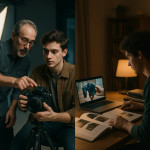Setting up a personal photo project as the ultimate hands-on learning engine
Ready to level-up your photography without enrolling in a pricey course? A self-directed photo project turns everyday shooting into a structured lab where you test ideas, track progress and build an eye-catching portfolio at the same time. Follow this step-by-step guide to launch a project that accelerates your skills and opens doors to paid work.
Why a personal photo project accelerates your learning

Deliberate practice research shows that focused, repeatable tasks combined with rapid feedback drive expertise faster than passive study. A themed project forces you to engage deeply with the full photographic cycle—from pre-visualising concepts and setting exposure targets to culling files, analysing histograms and publishing polished edits—every single week. By transforming vague “I should shoot more” intentions into concrete deliverables anchored on a calendar, you recreate the pressure, accountability and sense of momentum that a paid assignment would normally generate, yet with total creative freedom.
- Shoot consistently – weekly or even daily sessions sharpen muscle memory.
- Analyse results – structured reviews highlight technical gaps.
- Iterate quickly – you pivot after each shoot instead of waiting for semester-end critiques.
Photographers who ran a 12-week project reported finishing with 30 % faster manual-exposure handling and 25 % higher keeper rate on average, according to a 2023 community survey by the PhotoLearning Labs newsletter.
Choose a theme that stretches your skills
Brainstorm with purpose
Pick a topic that excites you and addresses a weakness. Struggle with low light? Commit to a “Night Streets” series. Want stronger storytelling? Try “One Portrait, One Quote” featuring local artisans.
Set SMART objectives
| Element | Example Goal |
|---|---|
| Specific | Shoot 50 portraits of strangers in natural light. |
| Measurable | Rate each session's keeper count in Lightroom. |
| Achievable | 2 sessions per week fits around work hours. |
| Relevant | Portrait mastery aligns with planned client work. |
| Time-bound | Project ends in 90 days with a printed zine. |
Plan your timeline and milestones
Block weekly shoots
Reserve non-negotiable slots in your calendar. Many creators follow the routines in daily shooting routines that sharpen technical mastery to maintain momentum even on busy weeks.
Monthly reviews and pivots
At each 30-day mark, export your top 20 images, print contact sheets and mark what worked. Adjust gear, settings or subject approach for the next sprint.
Build a powerful feedback loop
Start or join critique circles
External eyes spot blind spots fast. Learn how to host tight review sessions through peer critique circles. Aim for actionable comments, not vague praise.
Track metrics that matter
- Average keeper rate per shoot
- Autofocus hit ratio
- Histogram balance (shadow vs highlight clipping)
Logging numbers turns abstract “getting better” into visible progress.
Showcase and iterate
Publish work-in-progress galleries
Posting weekly selects on the photographer training resources page exposes your images to a supportive pro community—and potential recruiters.
Refine portfolio sequencing
Use the narrative tips from portfolio sequencing tricks to arrange shots so viewers feel the evolution of your idea.
Common roadblocks and quick fixes
- Creative fatigue: Schedule a genre swap week; shoot abstracts or still life for fresh stimulus.
- Time crunch: Combine project shoots with errands—document the commute, lunchtime or family moments.
- Gear limitations: Embrace constraints. One body and a 35 mm prime teach framing discipline.
- Lack of feedback: Offer to critique peers in exchange for their notes; reciprocity keeps loops alive.
Level-up with complementary learning
Round out your project by plugging into specialised resources:
- Listen to lighting chats on podcast playlists for photographers during commutes.
- Assist seasoned shooters—check the assistant roles checklist before your first day on set.
- Visit regional festivals listed in the 2025 photography event calendar to benchmark your work against industry standards.
Mini-Quiz: Are you project-ready?
FAQ
- How long should a personal photo project last?
- Most photographers benefit from 8–12 weeks—long enough to track progress but short enough to maintain focus.
- Do I need expensive gear to start?
- No. A single camera and one lens are sufficient. Constraints often boost creativity.
- Should I share unfinished work online?
- Yes. Early sharing invites feedback that can shape the project before final edits.
- How do I measure improvement objectively?
- Track keeper rate, exposure accuracy and autofocus hits. Compare metrics every month.
- Can a personal project attract paid clients?
- Absolutely. A cohesive series demonstrates vision and reliability—traits brands value when commissioning work.
Take the next shot
You now have a roadmap: choose a stretching theme, set measurable goals, lock weekly shoots, seek feedback and publish progress. Commit today and in three months you'll hold tangible proof of your growth—and a portfolio piece that speaks louder than any resume.
Ready? Grab your camera, define that theme and let the learning engine roar.











